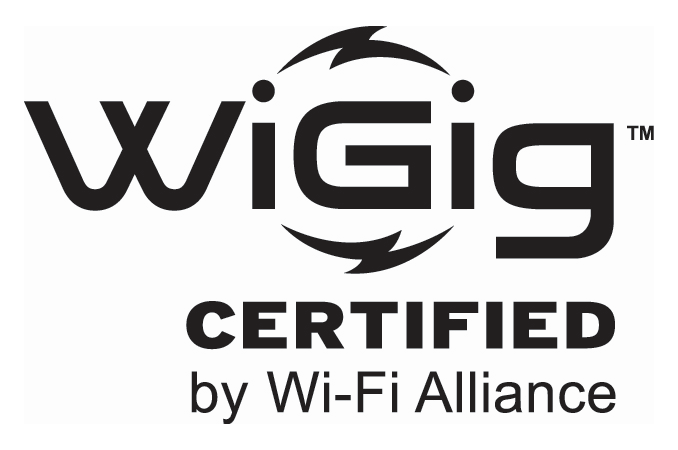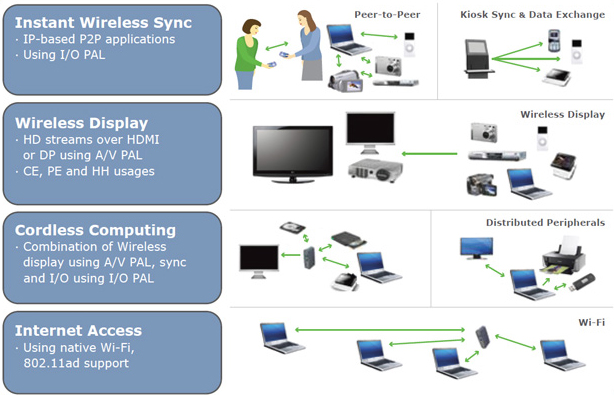Wi-Fi Alliance Begins to Certify 802.11ad WiGig Devices
by Anton Shilov on October 28, 2016 9:00 PM EST- Posted in
- Smartphones
- 802.11ad
- WiGig
- Wi-Fi
- Notebooks
- 60 GHz
- Wi-Fi Alliance

The Wi-Fi Alliance this week began to certify products featuring wireless modules compatible with the 802.11ad standard (aka WiGig). The certification will help to ensure that all WiGig-branded devices, which have been around for some time, can flawlessly operate with each other and deliver expected multi-gigabit performance over 60 GHz spectrum.
The WiGig technology (IEEE 802.11ad) is a short range communication standard that enables compatible devices to communicate at up to 7–8 Gb/s data rates and with minimal latencies, using the 60 GHz spectrum at distances of up to ten meters. Since 60 GHz signals cannot penetrate walls, the technology can be used to connect devices that are in direct line of sight. Given the limitation, WiGig cannot replace Wi-Fi or even Bluetooth, but it can enable devices like wireless docking stations, wireless AR/VR head-mounted displays, wireless high-performance storage devices, wireless displays, and others devices which need a lot of bandwidth.
To date, Intel and Qualcomm have released several tri-band chipsets that support the 2.4 GHz, 5 GHz and 60 GHz spectrums as well as Wi-Fi, Bluetooth and WiGig technologies. The Wi-Fi Alliance has already certified Intel’s Tri-Band Wireless 18260 (Maple Peak) and Qualcomm’s QCA9500 802.11ad-compatible chipsets as well as multiple devices that use them (including Dell’s Latitude E7450/70 as well as 802.11ad 60 GHz USB adapters from Peraso and Socionext). Going forward, the organization will certify other products, including smartphones and docking stations.
It should be noted that the start of WiGig certification on its own isn't going to be the catalyst to cause WiGig adoption to take off, but it will increase chipset developers', device makers', and end users' confidence in the standard. Designers of Wi-Fi chipsets and manufacturers of actual systems have been reluctant to adopt 802.11ad so far because the infrastructure is absent and so is demand, a classic chicken and egg dilemma. With the official certification process things will likely get a little better, mainly because of added confidence.
Meanwhile, analysts from ABI Research believe that 180 million of WiGig-enabled chipsets will ship inside smartphones already next year with 1.5 billion WiGig devices shipping in 2021.
Image Source: Blu Wireless Technology.
Source: Wi-Fi Alliance












50 Comments
View All Comments
CoreLogicCom - Friday, November 4, 2016 - link
HiMem.sys and emm386.exe are the two that Microsoft included in DOS. Then there was the really good Quarterdeck QEMM-386. You could cram large amounts of stuff into upper memory freeing as much memory below 640KB as possible. Really made playing popular games at the time easier.jtgmerk - Sunday, October 30, 2016 - link
presently i can't use all of the bandwidth. But if you build it, someone will make use of it. Bandwidth is like storage. Everyone claims you will never use it all, but it also seems that we never have enough.Jumangi - Sunday, October 30, 2016 - link
Pointless for them to have it.13Gigatons - Saturday, October 29, 2016 - link
So much hype. What's the real world speed?prisonerX - Saturday, October 29, 2016 - link
Typically it's have the rated speed.prisonerX - Saturday, October 29, 2016 - link
*halfBurntMyBacon - Monday, October 31, 2016 - link
It hasn't been half the rated speed since 802.11g. That was rated for 54Mbps, but only ever got an effective ~20-22Mbps. Sure you can set up some nice point to point, single direction, single device tests that make a nice benchmark for marketing, but in the real world, more than one device is accessing the wireless and often times, more than one wireless network is talking within the 20MHz side-lobes. If you are using 40MHz, 80MHz, or 160MHz channels to get the higher bandwidth offered by higher end routers, you raise that probability exponentially.BoyBawang - Saturday, October 29, 2016 - link
So what's the effect of this 60GHz signals passing through our brains?PixyMisa - Sunday, October 30, 2016 - link
Seems to be quite safe at the planned energy levels, because of the big limitation of 60GHz signals - they don't go through solid objects. Won't go through walls, and won't go through your skull either. Sitting in a room with a 60GHz access point should be only slightly more hazardous than moonlight. Much safer than going outside during the day.name99 - Sunday, October 30, 2016 - link
60GHz = 0.00025 eV=2.9KGiven that we're living in a sea of 300K photons, I think our fragile little bodies can handle being hit by a 3K photon...